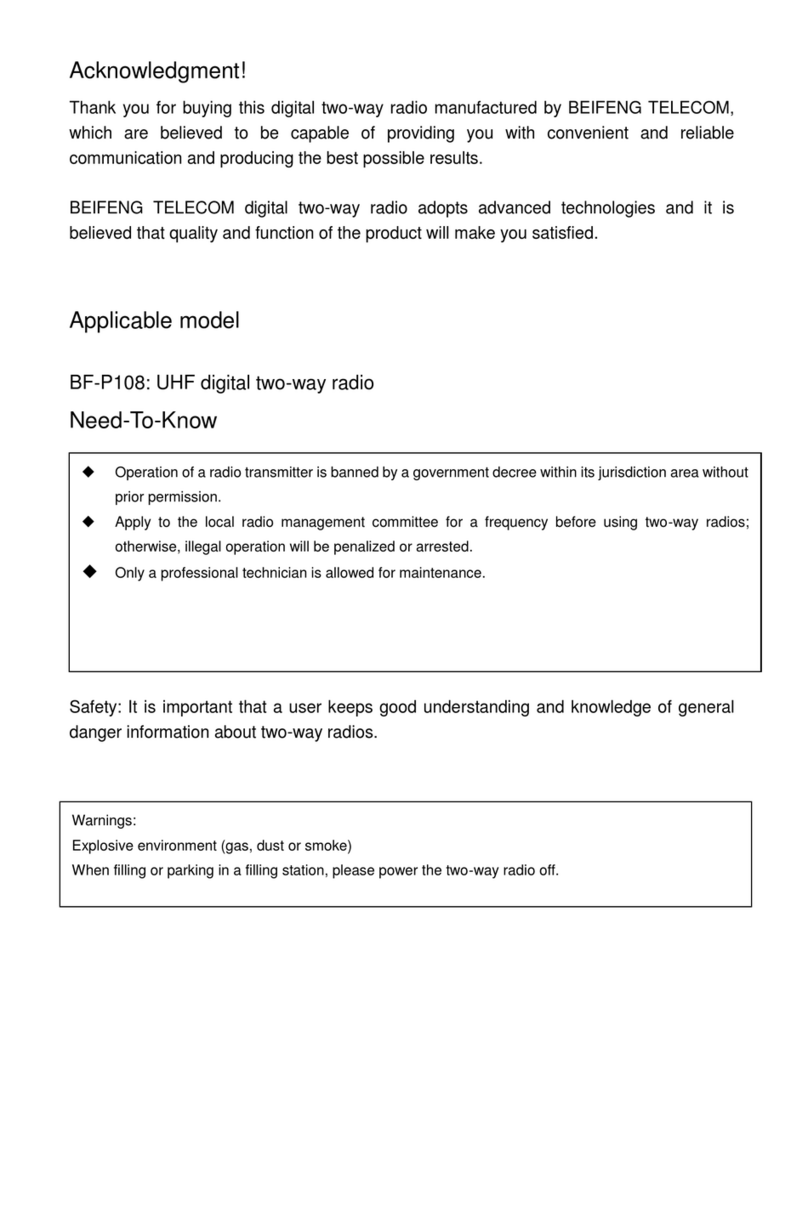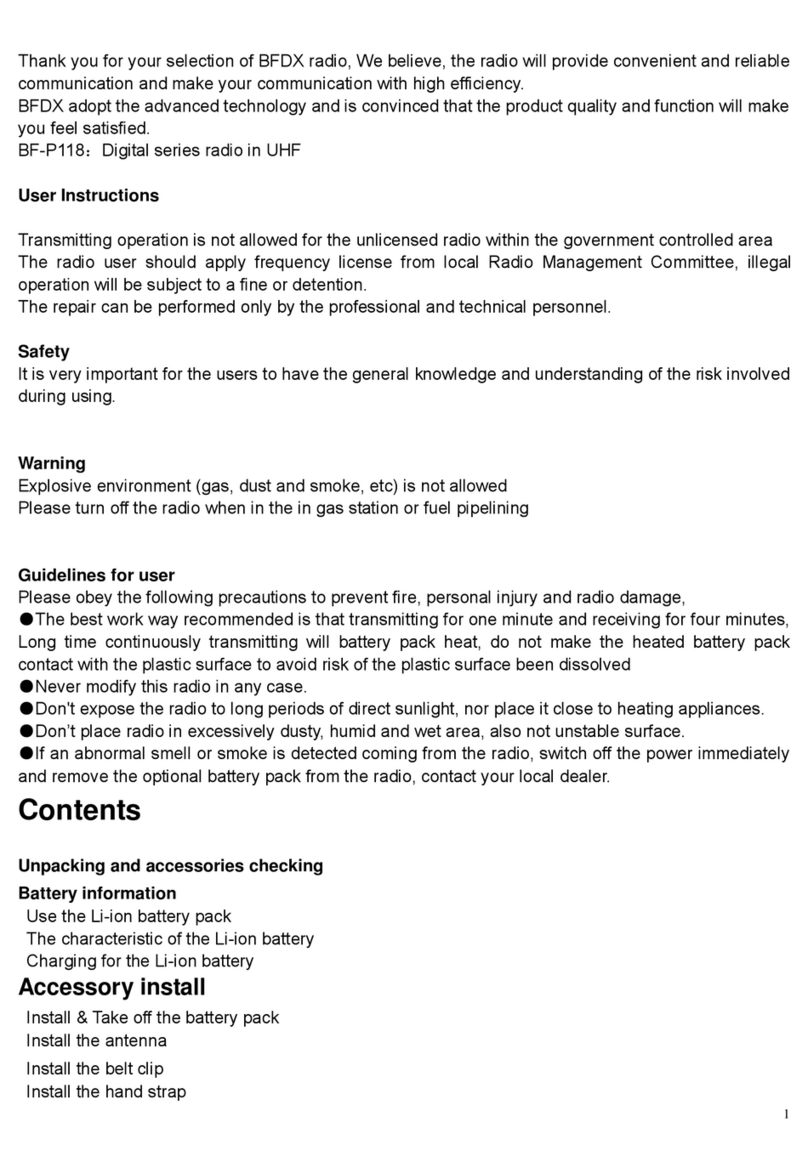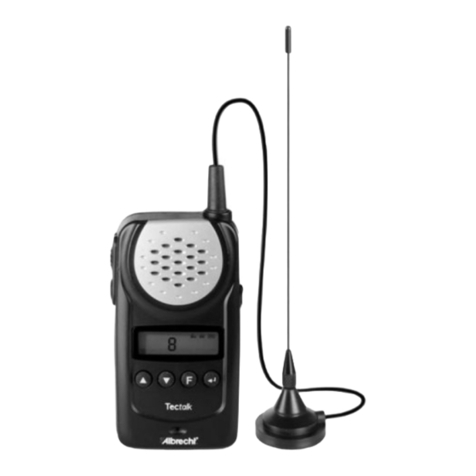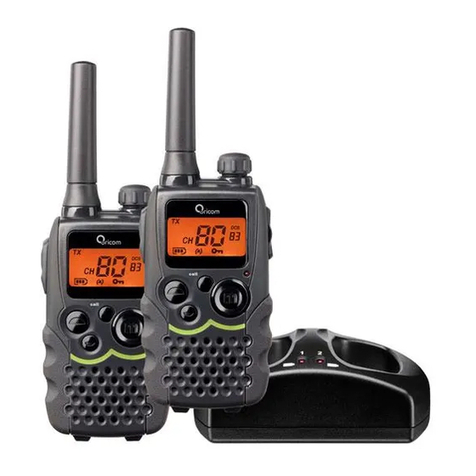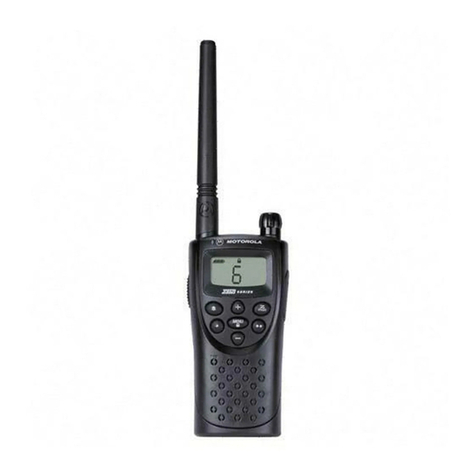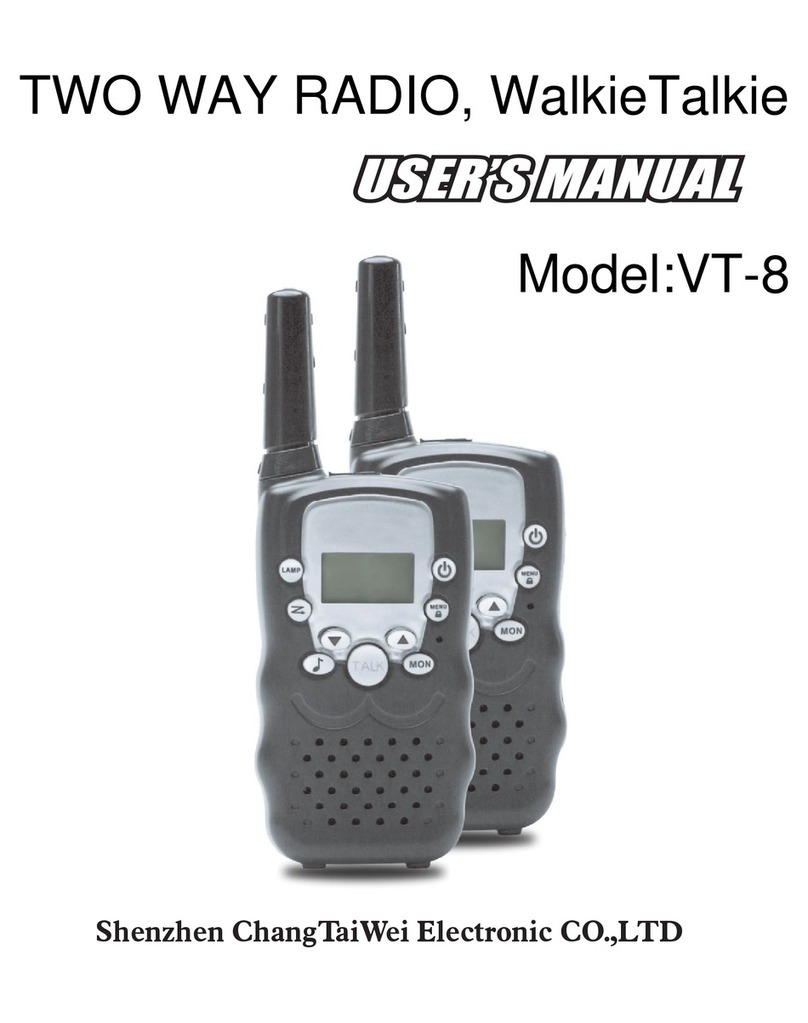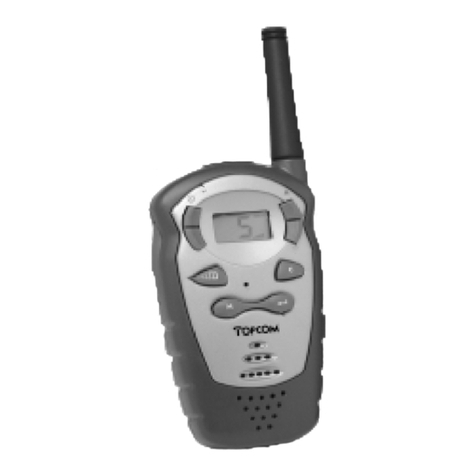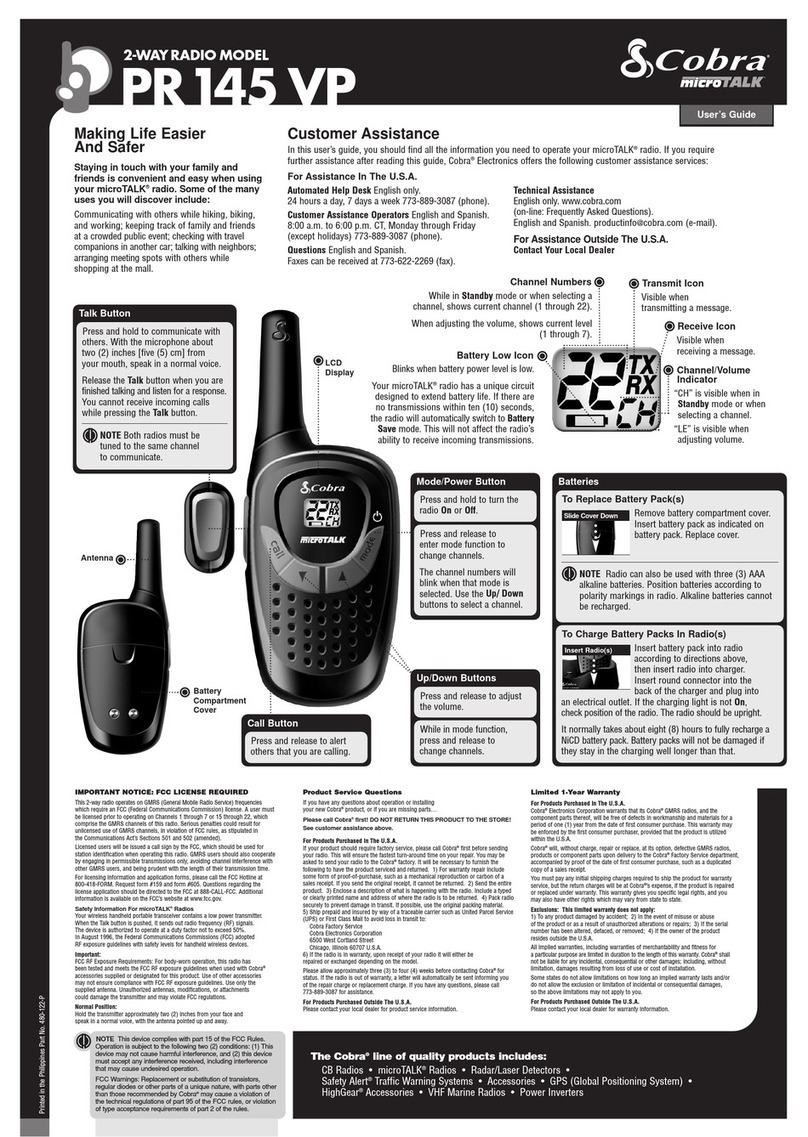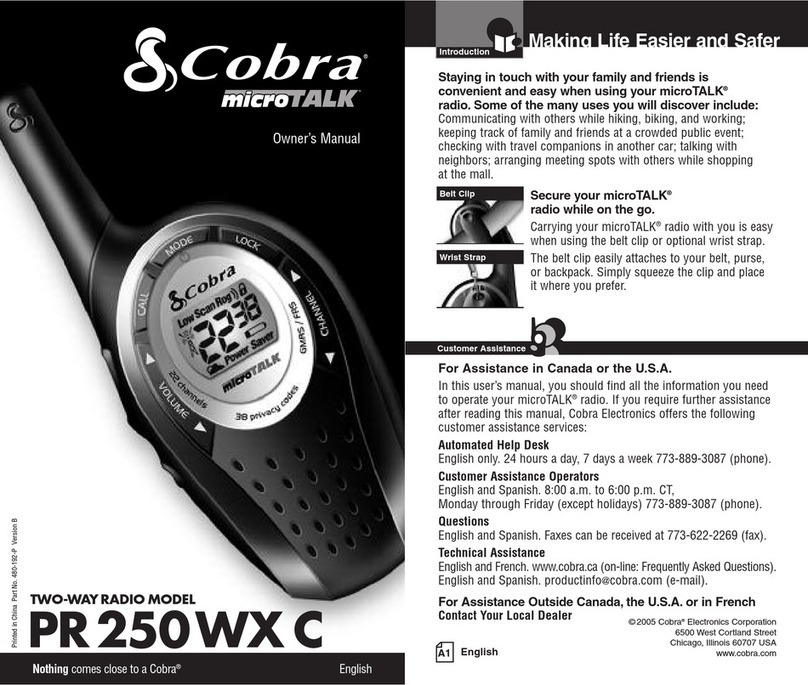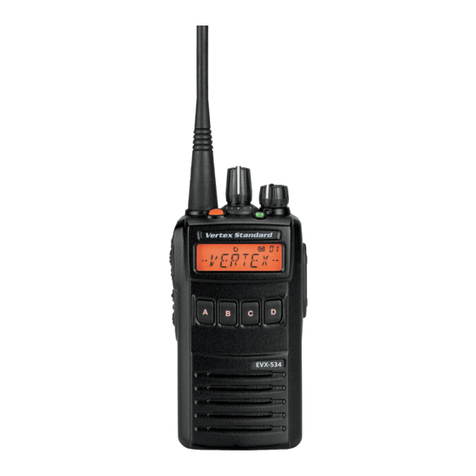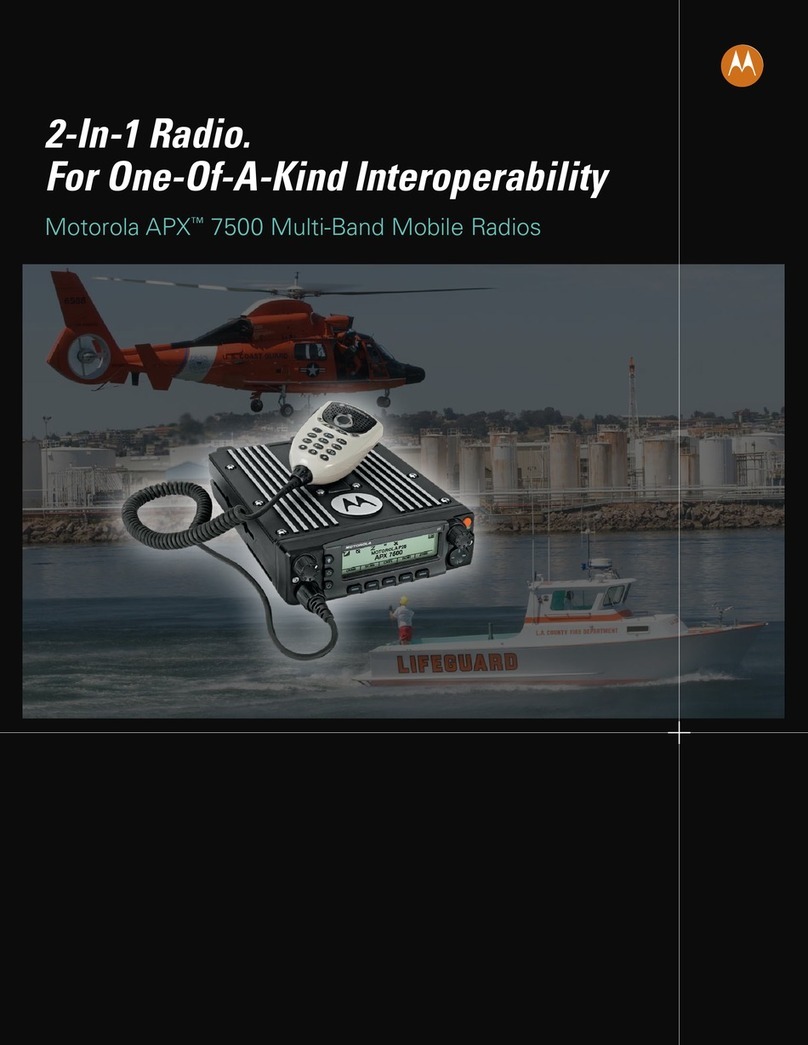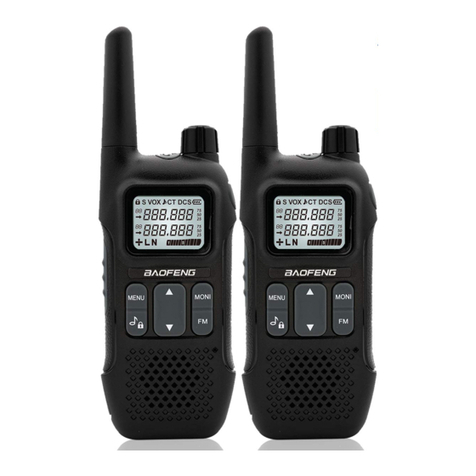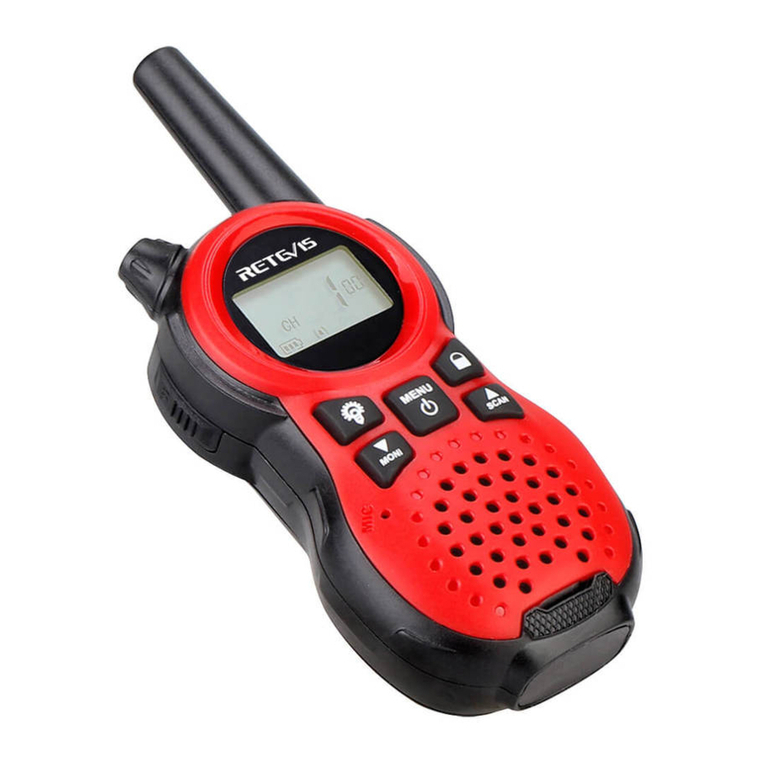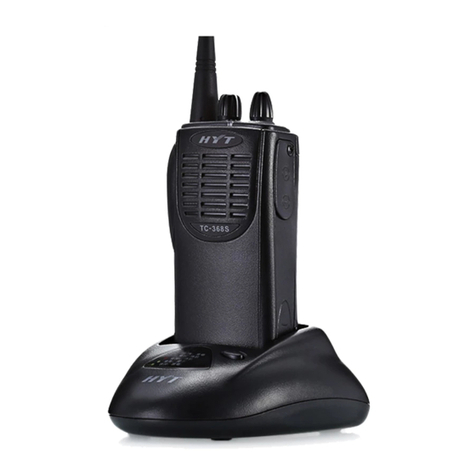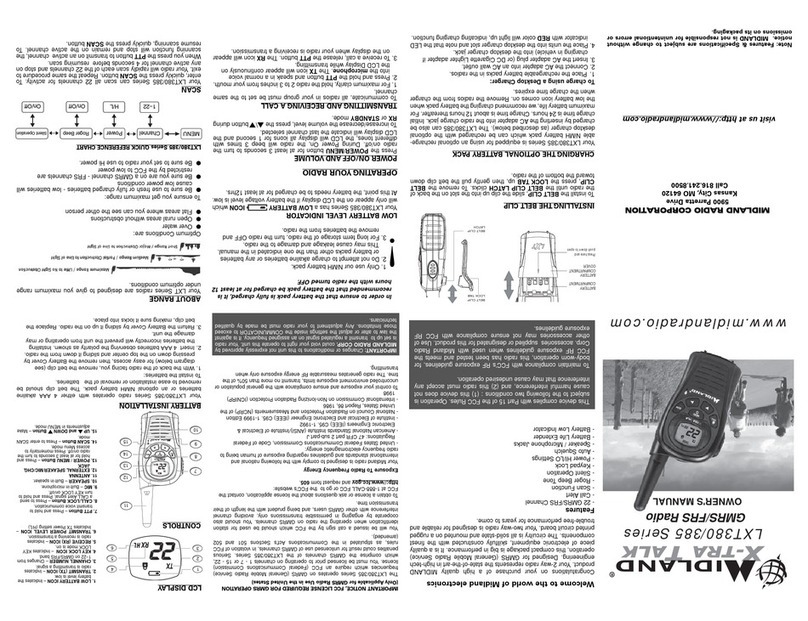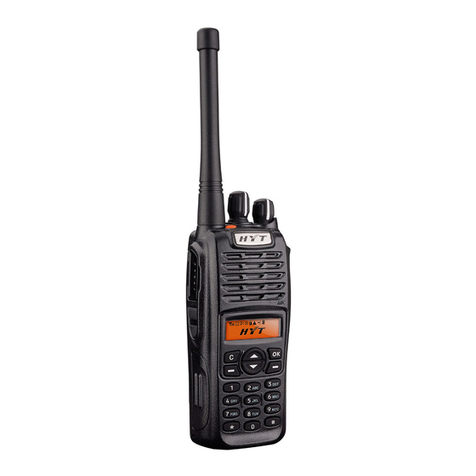BFDX BF-5208UHF User manual

Page 1 of 12
THE USER’S MANUAL
User Safety, Training, and General Information
READ THIS IMPORTANT INFORMATION ON SAFE AND EFFICIENT OPERATION BEFORE
USING YOUR BFDX PORTABLE TWO-WAY RADIO.
Compliance with RF Energy Exposure Standards
The two-way radio is designed and tested to comply with a number of national and international
standards and guidelines (listed below) regarding human exposure to radio frequency
electromagnetic energy. This radio complies with the IEEE (FCC) and ICNIRP exposure limits for
occupational/controlled RF exposure environment at duty cycles of up to 50% talk-50% listen and
should be used for occupational use only. In terms of measuring RF energy for compliance with the
FCC exposure guidelines, your radio radiates measurable RF energy only while it is transmitting
(during talking), not when it is receiving (listening) or in standby mode.
Note: The approved batteries supplied with this radio are rated for a 5-5-90 duty cycle (5% talk-5%
listen-90% standby), even though this radio complies with the FCC occupational RF exposure
limits at duty cycles of up to 50% talk.
Complies with the following of RF energy
exposure standards and guidelines:
United States Federal Communications Commission, Code of Federal Regulations; 47CFR part
2 sub-part J
American National Standards Institute (ANSI)/Institute of Electrical and Electronic Engineers
(IEEE) C95. 1-1992
Institute of Electrical and Electronic Engineers (IEEE) C95. 1-1999 Edition International
Commission on Non-Ionizing Radiation Protection (ICNIRP) 1998
Operational Instructions
To ensure optimal performance and compliance with the occupational/controlled environment RF
energy exposure limits in the above standards and guidelines, users should transmit no more than
50% of the time and always adhere to the following procedures:
Hand-held radio operation
Hold the radio in a vertical position with the microphone 5 cm away from the lips and let
the antenna farther away from your head.
Notices to the User
•Government law prohibits the operation of unlicensed radio transmitters within the territories
under government control.
•Illegal operation is punishable by fine or imprisonment or both.
•Refer service to qualified technicians only.
WARNING: It is important that the operator is aware of and understand hazards common to the
operation ofanytransceiver. Explosive environment(such as gases,dust, fumes, etc).Turn off your
transceiver while talking on fuel, or while parked in gasoline service stations.
If you require this machine to be developed or some changed, pleased connect with BFDX or your
BFDX dealer.

Page 2 of 12
FCC Caution:
This equipment has been tested and found to comply with the limits for a Class B digital
device, pursuant to part 15 of the FCC Rules. These limits are designed to provide
reasonable protection against harmful interference in a residential installation. This
equipment generates, uses and can radiate radio frequency energy and, if not installed
and used in accordance with the instructions, may cause harmful interference to radio
communications. However, there is no guarantee that interference will not occur in a
particular installation. If this equipment does cause harmful interference to radio or
television reception, which can be determined by turning the equipment off and on, the
user is encouraged to try to correct the interference by one or more of the following
measures:
_ Reorient or relocate the receiving antenna.
_ Increase the separation between the equipment and receiver.
_ Connect the equipment into an outlet on a circuit different from that to which the
receiver is connected.
_ Consult the dealer or an experienced radio/TV technician for help.
FCC Requirements
Your radio must be properly licensed Federal Communications Commission prior to use.
Your Wireless dealer can assist you in meeting these requirements. Your dealer will
program each radio with your authorized frequencies, signaling codes, etc., and will be
there to meet your communications needs as your system expands.
Precautions
Only qualified technicians are allowed to maintain this product.
Do not use the radio or charge a battery in explosive areas such as coal gas, dust,
steam, etc.
Switch OFF the radio while refueling or parking at gas station.
Do not modify or adjust this radio without permission.
Do not expose the radio to direct sunlight over a long time, nor place it close to
heating source.
Do not place the radio in excessively dusty, humid areas, nor on unstable surfaces.
Safety: It is important that the operator is aware of and understands hazards common
to the operation of any radio.
CE Caution:
Hereby, Fujian Quanzhou Beifeng Telecom Systems Co., Ltd. declares that this Tow-way
radio is in compliance with the essential requirements and other relevant provisions of
Directive 1999/5/EC and the COUNCIL RECOMMENDATION of 12 July 1999 on the limitation
of exposure by the general public to electromagnetic fields (0 Hz to 300 GHz) (1999/519/EC).
A copy of the DoC may be obtained through the following address.
Puren Industrial Area, Beimen Quanzhou, Fujian, China

Page 3 of 12
Training Guidelines
1.Only qualified technicians are allowed to maintain this product.
2.To avoid electromagnetic interference and/or compatibility conflicts, turn off your radio in any
place where posted notices instruct you to do so. Hospitals or health care facilities may be using
equipment that is sensitive to external RF energy. When on aircraft, turn off your radio when
airline crew instruct you to do so.
3. When in vehicles with an airbag, do not place a portable radio in the area over an airbag or in the
airbag deployment area.
4.Turn off your radio prior to entering any area with a potentially explosive atmosphere. Do not
remove, install, or charge batteries in such areas.
5.To avoid possible interference with blasting operations, turn off your radio when you are near
electrical blasting caps.
6.Do not use any portable radio that has a damaged antenna. If a damaged antenna comes into
contact with your skin, a minor burn may result.
7.Do not expose the radio in direct sunlight for a long time or place it close to a heating source.
8.When transmitting with a portable radio, hold the radio in a vertical position with its microphone
about 5 centimeters away from your mouth.
9.The communication range will be impacted in rainy or cloudy days or when you are in forest.
We are grateful you chose BFDX for your land mobile radio applications. We believe this
easy-to-use transceiver will provide dependable and reliable communication to personal operating
at peek efficiency.
BFDX transceiver incorporated the latest in advanced technology. As a result, we feel strongly that
you will be pleased with the quality and features of this product!

Page 4 of 12
CONTENTS
CHAPTER1PREPAREATION
Unpacking and checking equipment
Supplied Accessories
Preparation
Installing the antenna
Installing the hand strap
Getting acquainted
Basic operation
Senior operation
Scanning
QT/DQT
TOT (TIME-OUT TIMER)
Battery saver
Low power alert
BCL(Busy channel locked)
QT frequency (39 frequency chart)
DQT code (83 codes)
Technology Specification

Page 5 of 12
Unpacking and Checking Equipment
Note: the following explain for unpacking is aim to BFDX dealer, promised BFDX
service institution or factory.
Please carefully unpack the transceiver. We recommend you identify the items listed
in the following table. If any items are missing or have been damaged, please
immediately contact your BFDX dealer.
Supplied Accessories:
Item Quantity
Antenna 1
Hand strap 1
User Manual 1

Page 6 of 12
PREPARATION
INSTALLING/ UNPACKING THE BATTERY PACK
Note: Because the battery pack is provided uncharged, you must charge the battery
pack before using it with the transceiver. To charge the battery pack, refer To
CHARGING THE BATTERY PACK.
Position the two grooves on the edge and two hooks at
the bottom of the battery over the corresponding guides
on the back of the transceiver.
Slide the battery pack along the back of the transceiver
until the release latch on the top of the transceiver
locks the battery pack in place.
To remove the battery pack, push the release latch on
top, then slide the battery pack down.

Page 7 of 12
INSTALLING THE ANTENNA
.
Hold the base of the supplied antenna, then
screwing the antenna into connector on the
top panel of the transceiver until secure
INSTALLING THE HAND STRAP
Loop the hand strap through the ring on the
back of the transceiver.

Page 8 of 12

Page 9 of 12

Page 10 of 12
Senior operation
Auto-call function
After turning on the power switch, when turn the selector, it with tone calling,
from 1 channel to 16 channels, which enables you to select the channel conveniently.
Monitor/squelch function OFF.
To receive the weak signals, the channels doesn’t work or no signals to adjust the
volume by this function.
Instant squelch function OFF: press to receive the background noise, release to get
back the operation station.
Scan
1. If transceiver was set up at least 2 channels to scan, after pressing scan key
for 1 second, the transceiver will check the channels automatically until check
the signal to stop. Meanwhile it stay this channel until the signal disappear,
if the signal disappear at once, the transceiver will stay for 5 second then
scan.
2. when scan, LED glitters green, if receive signal, LED displays green(not glitter).
If you want to stop scan, press scan switch for 1 second again. The channel
of transceiver will stay the coder’s channel.
3. press PTT keypad to transmit, the transceiver will choose the channels, which
is the latest used.
QT/DQT
QT/DQT signals would be set up by the dealer. QT/DQT coder is mute volume/ coder,
it enables you ignore the same channel to call other people.
If one channel is set up the QT/DQT coder, it just can receive the exact frequency
or coder’s signal to use squelch. So, QT/DQT mode same as your transceiver of the
broadcast station just receive your signal. The squelch would not opened, if other
use different QT/DQT in the same channel to call, so you will not listen the call,
it enables you ignore these calls. It seems like you have personal channels with
QT/DQT, but, if others set up the same QT/DQT, they still can hear your call.
Time-out timer
The Time-out Timer (TOT) limits the time of each transmission. The built-in time-out
timer limits each transmission time to a maximum of 300seconds. Just before the
transceiver stops the transmission, a warning beeps sounds. It is necessary to
protect the transceiver from thermal damage. You can turn this function OFF.
Battery power-saving
When it doesn’t receive the signal or doesn’t operate (don’t press keypad, don’t
turn switch), the battery power-saving can reduce power. When the channels is no
t busy and not operated for 5 seconds, the battery power-saving turned on, when

Page 11 of 12
receive the signals or operate, battery power-saving turn off.
Low power alert
It appears when need charger or change the battery. If battery power is lower than
6V to receive or transmit, LED displays red and appears “DU”sound.
Busy channel locked
When turn on the keypad, in the same channel, when it is busy, if press PTT keypad,
it will appears “DU”sound to alert and prohibit to transmit. Release PTT switch
to stop alert sound and back to the receive mode.
QT FREQUENCY CHART (39 FREQUENCIES)
QT
NO
Frequency
HZ
QT
NO
Frequency
HZ
QT
NO
Frequency
HZ
QT
NO
Frequency
HZ
1 67.0 11 94.8 21 131.8 31 186.2
2 69.3 12 97.4 22 136.5 32 192.8
3 71.9 13 100.0 23 141.3 33 203.5
4 74.4 14 103.5 24 146.2 34 210.7
5 77.0 15 107.2 25 151.4 35 218.1
6 79.7 16 110.9 26 156.7 36 225.7
7 82.5 17 114.8 27 162.2 37 233.6
8 85.4 18 118.8 28 167.9 38 241.8
9 88.5 19 123.0 29 173.8 39 250.3
10 91.5 20 127.3 30 179.9
DCS(83 CODES)
023 114 174 315 445 631
025 115 205 331 464 632
026 116 223 343 465 654
031 125 226 346 466 662
032 131 243 351 503 664
043 132 244 364 506 703
047 134 245 365 516 712
051 143 251 371 532 723
054 152 261 411 546 731
065 155 263 412 565 732
071 156 265 413 606 734
072 162 271 423 612 743
073 165 306 431 624 754
074 172 311 432 627

Page 12 of 12
Technical Specifications
Model BF-5208UHF
Frequency range
430-470MHz
Low frequency range 430.185-430.560MHz
Middle frequency range from 450.185-450.560MHz
High frequency range from 469.610-469.985MHz
(The channel/frequency is capable of operating on any specified
frequency of the band listed.)
Channels 16
Channel space 25KHz
Operating temperature range -20 to +60℃℃
Power supply 7.2V DC (±20%)
Volume 55(L)×33(W)×123(H)mm
Weight 350g(including the battery pack)
Transmitter UHF
Power output 3.13W (Conducted)
Frequency stability ±5ppm
Modulated mode 16K¢F3E
Spurious emissions ≤-70dB
FM noise ≤-40dB
FM distortion ≤5%
Maximum frequency
deviation ≤±5HKz
Receiver UHF
Frequency stability ±5ppm
Selectivity (at 12dB SINARD) Better than 0.25µV
Receiving FM bandwidth ≥±7KHz
Adjacent channel selectivity ≥65dB
Intermodulation rejection ratio ≥60dB
Anti interfere of spurious
wave ≥60dB
Audio output power 500mW
Table of contents
Other BFDX Two-way Radio manuals
